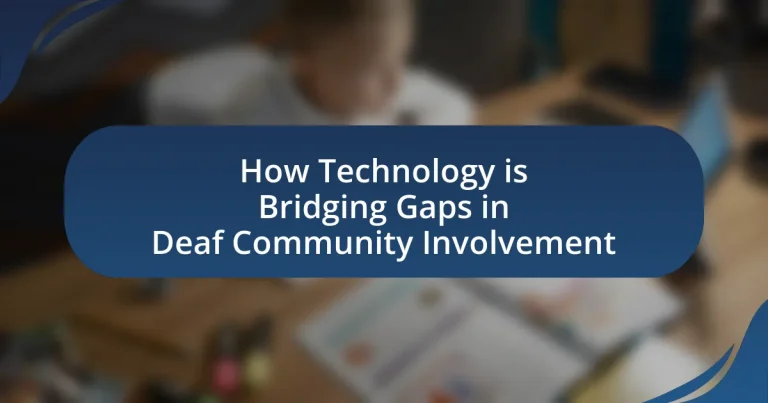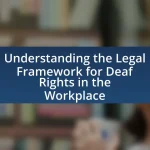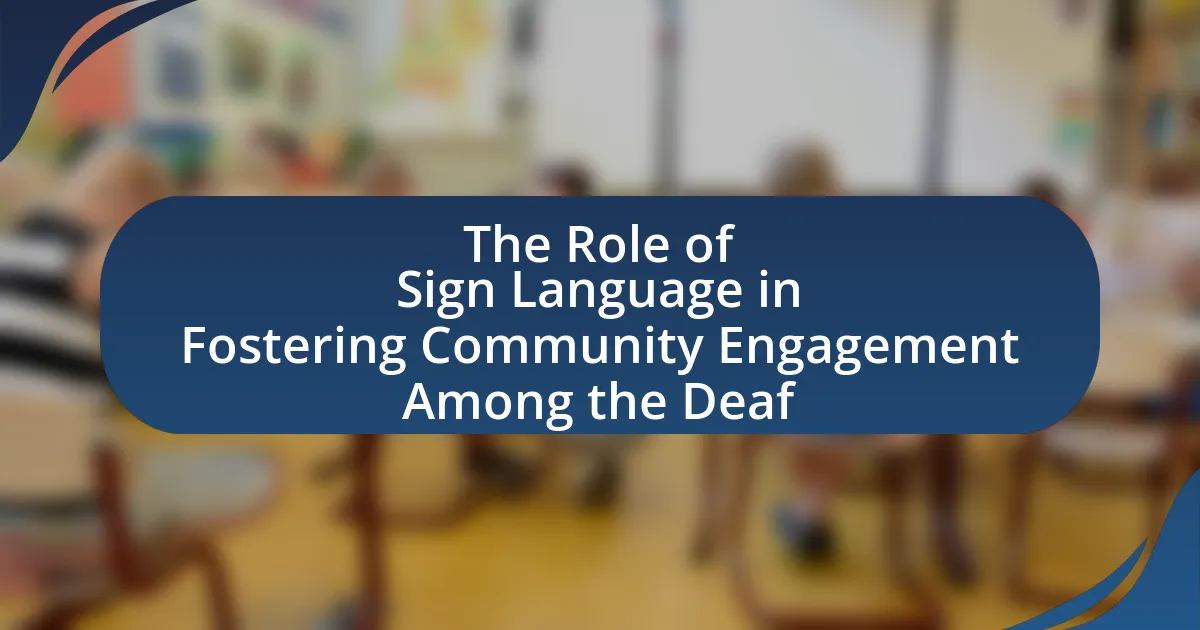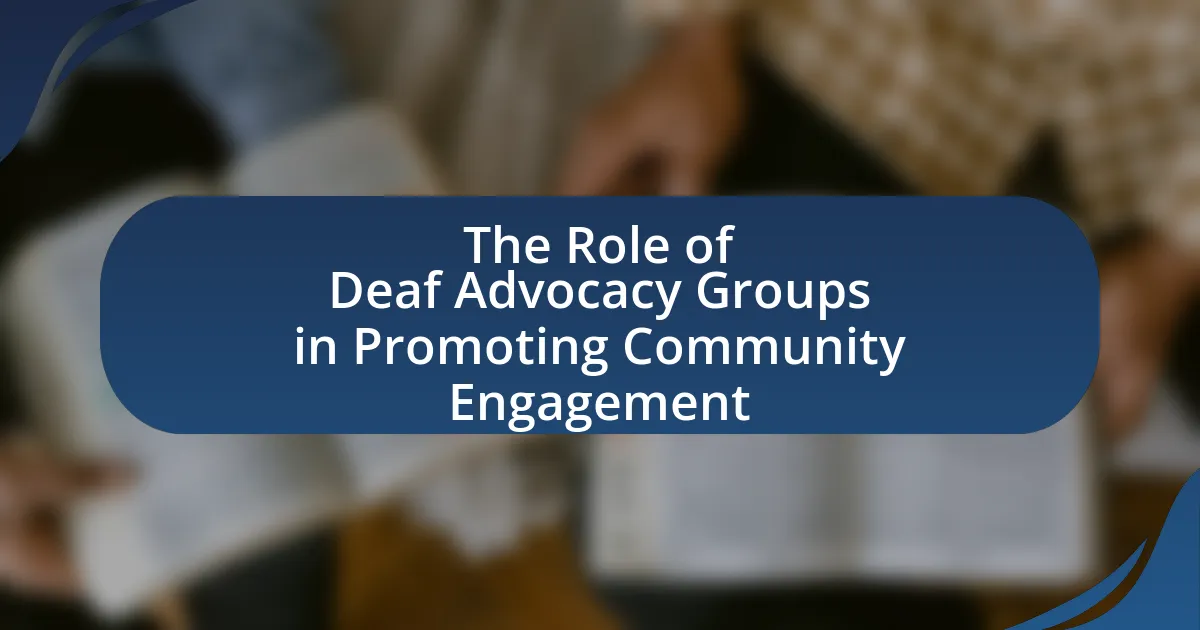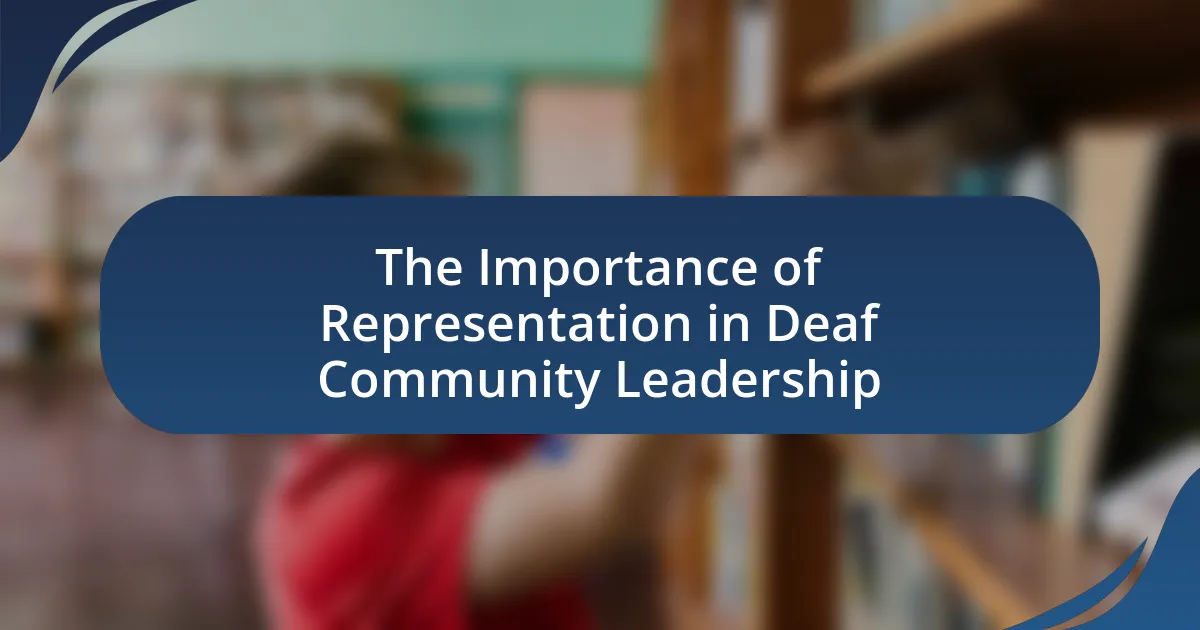The article focuses on how technology is bridging gaps in Deaf community involvement by enhancing communication and accessibility. It highlights key innovations such as video relay services, real-time captioning, and mobile applications that facilitate effective interaction in various settings, including social, educational, and professional environments. The article also discusses the importance of community involvement for mental well-being, the challenges faced by the Deaf community, and the role of social media in fostering connections. Additionally, it explores future technological advancements and best practices organizations can adopt to improve accessibility for Deaf individuals.
How is Technology Impacting the Deaf Community’s Involvement?
Technology is significantly enhancing the Deaf community’s involvement by providing accessible communication tools and platforms. Innovations such as video relay services, real-time captioning, and mobile applications enable Deaf individuals to engage more effectively in social, educational, and professional settings. For instance, the use of video conferencing tools allows for sign language interpretation, facilitating remote participation in meetings and events. Additionally, studies indicate that 90% of Deaf individuals report improved communication through text messaging and social media, which fosters community connections and reduces isolation. These advancements demonstrate that technology is not only bridging communication gaps but also empowering the Deaf community to participate more fully in society.
What are the primary technologies enhancing communication for the Deaf community?
The primary technologies enhancing communication for the Deaf community include video relay services (VRS), video remote interpreting (VRI), and text messaging applications. VRS allows Deaf individuals to communicate with hearing people through a sign language interpreter via video calls, facilitating real-time conversations. VRI provides on-demand interpreting services for in-person situations, enabling effective communication in various settings such as hospitals and businesses. Text messaging applications, including SMS and instant messaging platforms, offer a straightforward method for Deaf individuals to communicate without the need for voice calls. These technologies have significantly improved accessibility and interaction for the Deaf community, as evidenced by the increasing adoption rates and user satisfaction reported in studies on communication accessibility.
How do video relay services facilitate conversations for Deaf individuals?
Video relay services (VRS) facilitate conversations for Deaf individuals by providing a platform that connects them with hearing individuals through a sign language interpreter via video technology. This service allows Deaf users to communicate in their preferred language, American Sign Language (ASL), while the interpreter translates the conversation in real-time to the hearing person, ensuring effective communication. According to the Federal Communications Commission, VRS has significantly improved accessibility for Deaf individuals, enabling them to engage in phone conversations, participate in business discussions, and maintain personal relationships, thereby enhancing their overall involvement in the community.
What role do mobile applications play in improving accessibility for the Deaf?
Mobile applications significantly enhance accessibility for the Deaf by providing tools for communication, information access, and social interaction. These applications, such as video relay services and instant messaging platforms, enable Deaf individuals to communicate effectively with hearing individuals and each other through text and sign language. For instance, a study by the National Institute on Deafness and Other Communication Disorders highlights that mobile apps facilitate real-time captioning and sign language interpretation, which are crucial for participation in various activities, including education and employment. Furthermore, apps designed for emergency alerts and public service announcements ensure that Deaf individuals receive critical information promptly, thereby improving their overall safety and inclusion in society.
Why is community involvement important for the Deaf community?
Community involvement is crucial for the Deaf community as it fosters social connections, enhances access to resources, and promotes advocacy for rights and services. Engaging in community activities allows Deaf individuals to build relationships, share experiences, and create a sense of belonging, which is essential for mental well-being. Furthermore, active participation in community initiatives leads to increased visibility and awareness of Deaf culture, helping to combat stereotypes and discrimination. Research indicates that communities with strong Deaf involvement report higher levels of satisfaction and access to necessary services, demonstrating the tangible benefits of such engagement.
How does social interaction benefit the mental health of Deaf individuals?
Social interaction significantly benefits the mental health of Deaf individuals by fostering a sense of belonging and reducing feelings of isolation. Engaging with peers in the Deaf community enhances emotional well-being, as studies indicate that social connections can lead to lower rates of depression and anxiety among Deaf individuals. For instance, research published in the Journal of Deaf Studies and Deaf Education highlights that strong social networks contribute to improved mental health outcomes by providing support and understanding unique to their experiences.
What are the challenges faced by the Deaf community in participating in society?
The Deaf community faces significant challenges in participating in society, primarily due to communication barriers, lack of accessibility, and social stigma. Communication barriers arise from the predominance of spoken language in public settings, which can hinder effective interaction for Deaf individuals who primarily use sign language. Lack of accessibility is evident in inadequate provision of interpreters, captioning, and assistive technologies in various environments such as workplaces, educational institutions, and public services. Social stigma contributes to isolation and discrimination, as misconceptions about Deaf individuals’ capabilities can lead to exclusion from social and professional opportunities. These challenges collectively impede the full participation of the Deaf community in societal activities.
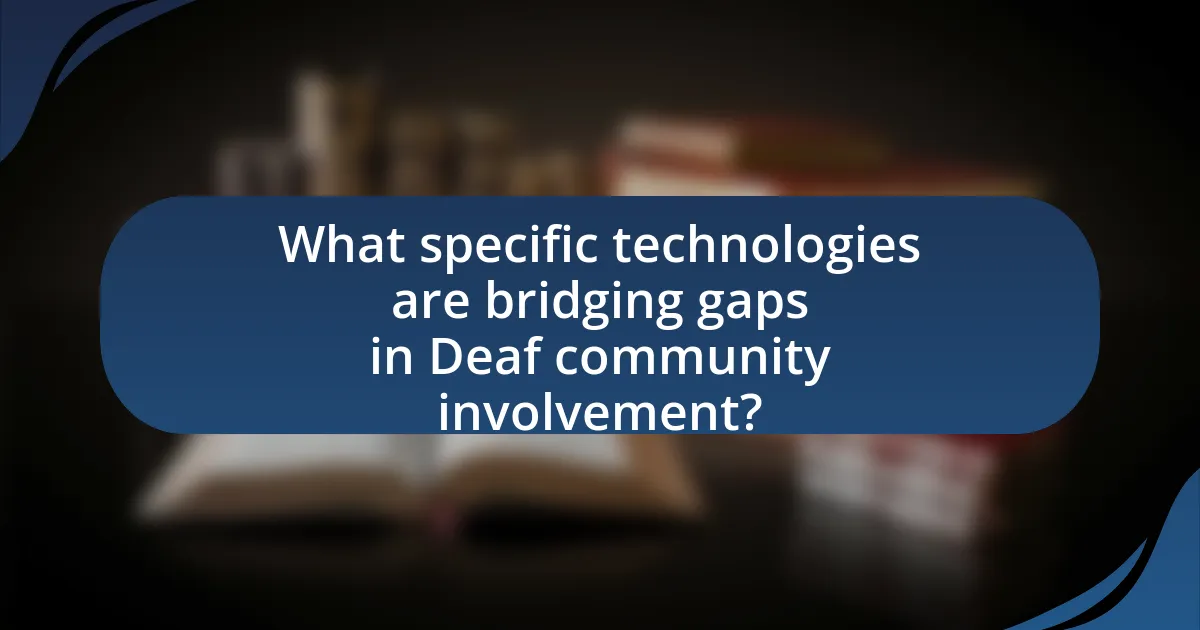
What specific technologies are bridging gaps in Deaf community involvement?
Specific technologies bridging gaps in Deaf community involvement include video relay services (VRS), real-time text (RTT), and mobile applications designed for communication. VRS allows Deaf individuals to communicate with hearing people through a sign language interpreter via video, enhancing accessibility. RTT enables text communication in real-time during phone calls, facilitating immediate interaction. Additionally, mobile applications like Glide and Sorenson’s P3 enable video messaging and direct communication, further promoting engagement within the community. These technologies collectively improve access to information and social interaction for Deaf individuals, as evidenced by increased usage statistics and positive feedback from users.
How do assistive listening devices enhance participation in public events?
Assistive listening devices enhance participation in public events by improving sound clarity and reducing background noise for individuals with hearing impairments. These devices, such as hearing aids and FM systems, directly transmit sound from the source to the listener, allowing for better comprehension of speech and audio content. Research indicates that users of assistive listening devices report increased engagement and satisfaction during events, as they can follow conversations and presentations more effectively. For example, a study published in the Journal of the American Academy of Audiology found that 90% of participants using assistive listening technology felt more included in social settings, demonstrating the significant impact these devices have on fostering inclusivity in public events.
What types of assistive listening devices are available for Deaf individuals?
Assistive listening devices available for Deaf individuals include hearing aids, cochlear implants, FM systems, infrared systems, and loop systems. Hearing aids amplify sound, while cochlear implants convert sound into electrical signals for direct stimulation of the auditory nerve. FM systems use radio waves to transmit sound from a microphone to a receiver, enhancing clarity in noisy environments. Infrared systems transmit sound via infrared light, suitable for one-on-one conversations or small groups. Loop systems create a magnetic field that transmits sound directly to hearing aids equipped with telecoils, improving sound quality in public venues. These devices collectively enhance communication and participation for Deaf individuals in various settings.
How effective are these devices in various environments?
These devices are highly effective in various environments, significantly enhancing communication for the deaf community. For instance, in quiet settings like classrooms, devices such as hearing aids and real-time captioning systems improve auditory access and comprehension. In noisy environments, like public places, technologies like noise-canceling features in hearing aids and visual alert systems help users remain engaged and informed. Research indicates that the use of assistive listening devices can increase speech understanding by up to 80% in challenging acoustic conditions, demonstrating their adaptability and effectiveness across different settings.
What impact do social media platforms have on Deaf community engagement?
Social media platforms significantly enhance engagement within the Deaf community by providing accessible communication channels and fostering connections. These platforms enable Deaf individuals to share experiences, resources, and information in a visual format, which is crucial for effective communication. For instance, research indicates that 90% of Deaf individuals use social media to connect with others, highlighting its role in building community and support networks. Additionally, social media facilitates the dissemination of information about events, advocacy, and educational resources, further promoting active participation in societal issues.
How are Deaf individuals using social media to connect with others?
Deaf individuals are using social media platforms to connect with others by sharing experiences, fostering community, and enhancing communication through visual content. These platforms, such as Facebook, Instagram, and TikTok, allow Deaf users to create and engage with video content, which is particularly effective for sign language communication. Research indicates that 90% of Deaf individuals use social media to maintain relationships and build networks, highlighting its role in combating social isolation. Additionally, social media provides a space for advocacy and awareness, enabling Deaf individuals to share their culture and challenges with a broader audience, thus promoting inclusivity and understanding.
What are the benefits and drawbacks of social media for the Deaf community?
Social media offers significant benefits and drawbacks for the Deaf community. The primary benefit is enhanced communication and connection, allowing Deaf individuals to engage with a broader audience, share experiences, and access information in real-time through visual platforms like video and sign language. For instance, studies show that 90% of Deaf individuals use social media to connect with others, fostering a sense of community and belonging.
Conversely, a notable drawback is the prevalence of misinformation and accessibility issues. Many social media platforms lack adequate features for sign language interpretation or captioning, which can lead to misunderstandings and exclusion from important discussions. Research indicates that 70% of Deaf users report challenges in accessing content that is not visually accessible, highlighting the need for improved inclusivity in digital spaces.
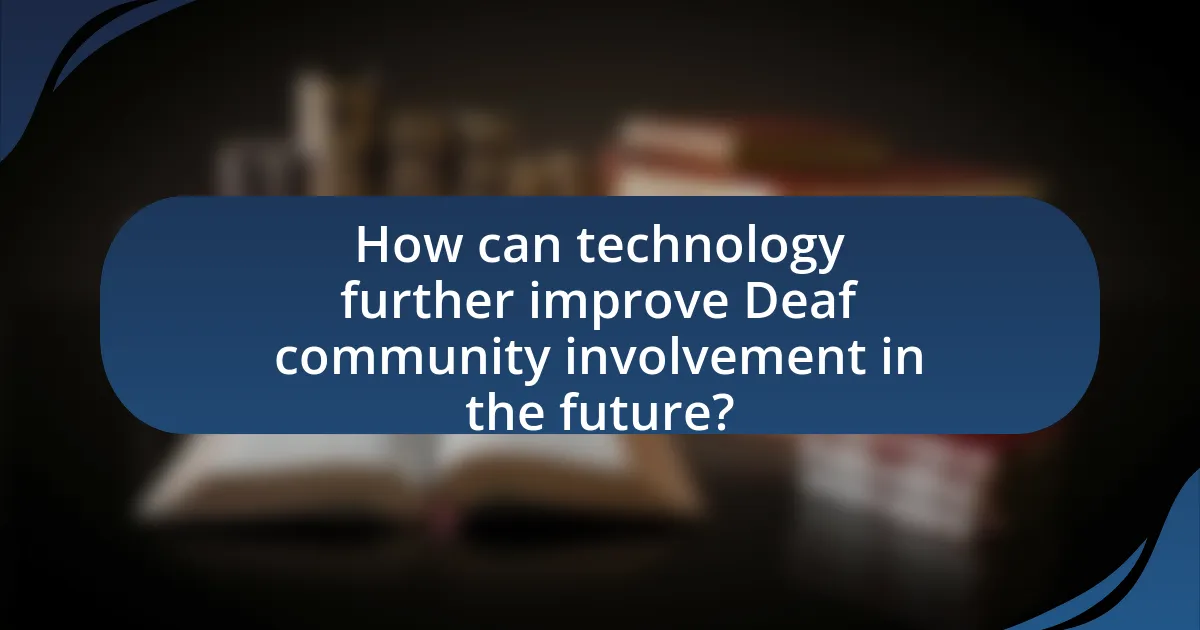
How can technology further improve Deaf community involvement in the future?
Technology can further improve Deaf community involvement in the future by enhancing communication accessibility through advanced tools like real-time captioning, video relay services, and augmented reality applications. These innovations facilitate seamless interactions in various settings, such as education, workplaces, and social environments. For instance, real-time captioning technology has been shown to increase participation rates in educational settings by up to 30%, allowing Deaf individuals to engage more fully in discussions and lectures. Additionally, video relay services enable Deaf individuals to communicate with hearing people via sign language interpreters, significantly improving access to essential services. Augmented reality applications can provide visual cues and information in real-time, further bridging communication gaps. These technological advancements collectively empower the Deaf community, fostering greater inclusion and participation in society.
What innovations are on the horizon for Deaf communication technologies?
Innovations on the horizon for Deaf communication technologies include advancements in real-time captioning, augmented reality (AR) applications, and AI-driven sign language recognition systems. Real-time captioning technologies are evolving to provide more accurate and context-aware transcriptions during live events, enhancing accessibility. AR applications are being developed to overlay sign language interpretations onto live video feeds, allowing for seamless communication in various environments. Additionally, AI-driven sign language recognition systems are improving in accuracy and speed, enabling better interaction between Deaf individuals and non-signers through automated translation. These innovations are supported by ongoing research and development efforts in the fields of linguistics, computer science, and accessibility technology.
How might artificial intelligence enhance accessibility for the Deaf?
Artificial intelligence can enhance accessibility for the Deaf by providing real-time speech-to-text transcription and sign language interpretation. Technologies such as automatic speech recognition (ASR) convert spoken language into written text, allowing Deaf individuals to follow conversations in real-time. For instance, AI-driven applications like Ava and Otter.ai have demonstrated effectiveness in transcribing live discussions, making information more accessible. Additionally, AI can facilitate sign language recognition, enabling communication between hearing individuals and Deaf users through platforms that translate spoken language into sign language. Research indicates that these AI applications significantly improve communication access, thereby fostering greater inclusion in various social and professional settings.
What potential developments in virtual reality could benefit the Deaf community?
Potential developments in virtual reality that could benefit the Deaf community include enhanced sign language interpretation and immersive communication environments. These advancements can facilitate real-time sign language translation within virtual spaces, allowing Deaf individuals to engage more fully in social and professional interactions. For instance, VR platforms can incorporate avatars that accurately mimic sign language, providing a more natural communication experience. Additionally, VR can create environments where Deaf users can interact with others through visual cues and gestures, promoting inclusivity. Research indicates that immersive technologies can improve learning outcomes for Deaf individuals by providing visual and interactive content, thus reinforcing the effectiveness of virtual reality as a tool for bridging communication gaps.
What best practices can organizations adopt to support Deaf community involvement?
Organizations can adopt several best practices to support Deaf community involvement, including providing sign language interpreters, utilizing captioning services, and ensuring accessible communication platforms. By offering sign language interpreters at events and meetings, organizations facilitate direct communication, which is essential for full participation. Captioning services for videos and live broadcasts enhance accessibility, allowing Deaf individuals to engage with content effectively. Additionally, using communication platforms that support text-based interactions, such as instant messaging or email, ensures that Deaf individuals can communicate without barriers. These practices align with the Americans with Disabilities Act, which mandates effective communication for individuals with disabilities, thereby reinforcing the importance of inclusivity in organizational settings.
How can organizations ensure their events are accessible to Deaf individuals?
Organizations can ensure their events are accessible to Deaf individuals by providing sign language interpreters, captioning services, and utilizing assistive listening devices. Sign language interpreters facilitate real-time communication, allowing Deaf attendees to engage fully with speakers and presentations. Captioning services, whether live or pre-recorded, ensure that visual text is available for videos and speeches, enhancing comprehension. Additionally, assistive listening devices can amplify sound for those who may have residual hearing. Research indicates that 15% of the U.S. population experiences some form of hearing loss, highlighting the importance of these accommodations for inclusivity.
What resources are available for organizations looking to improve Deaf accessibility?
Organizations looking to improve Deaf accessibility can utilize resources such as the National Association of the Deaf (NAD), which provides guidelines and advocacy tools for enhancing accessibility. Additionally, the World Health Organization (WHO) offers resources on communication access and best practices for engaging with Deaf individuals. The Gallaudet University’s Center for Continuing Education and Training provides training programs focused on Deaf culture and accessibility strategies. These resources are validated by their established roles in promoting Deaf rights and accessibility standards, ensuring organizations can effectively implement changes.
